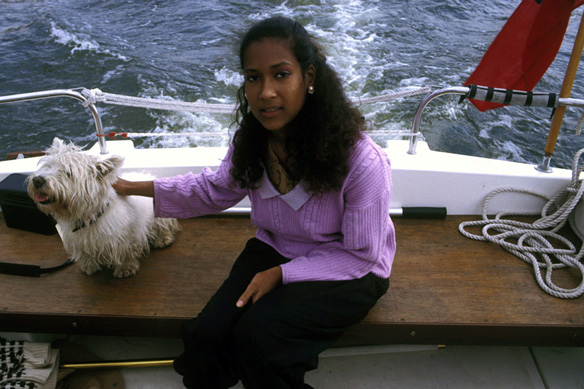
On 25 January 2006, officials from a north London housing association repossessing a bedsit in Wood Green owing to rent arrears made a grim discovery. Lying on the sofa was the skeleton of a 38-year-old woman who had been dead for almost three years. In a corner of the room the television set was still on, tuned to BBC1, and a small pile of unopened Christmas presents lay on the floor. Washing up was heaped in the kitchen sink and a mountain of post lay behind the front door. Food in the refrigerator was marked with 2003 expiry dates. The dead woman’s body was so badly decomposed it could only be identified by comparing dental records with an old holiday photograph of her smiling. Her name was revealed to be Joyce Carol Vincent.
I first heard about Joyce when I picked up a discarded copy of the Sun on a London underground train. The paper reported the gothic circumstances of her death – “Woman dead in flat for three years: skeleton of Joyce found on sofa with telly still on” – but revealed almost nothing about her life. There was not even a
photograph of her.
Joyce Carol Vincent in a studio photo
News of Joyce’s death quickly made it into the global media, which registered shock at the lack of community spirit in the UK. The story ran on in the British press, but still no photograph of Joyce appeared and little personal information.
Soon Joyce dropped out of the news. I watched as people discussed her in internet chatrooms, wondering if she was an urban myth, or talking about her as though she never mattered, calling her a couch potato, and posting comments such as: “What’s really sad is no one noticed she was missing – must have been one miserable bitch.” And then even that kind of commentary vanished.
But I couldn’t let go. I didn’t want her to be forgotten. I decided I must make a film about her.
At this point all that had been revealed in the press was that Joyce Vincent was 38 when she died, had been born in west London to parents who were from the Caribbean, and that some of her family had attended her inquest. Some reports suggested Joyce was, or had been, engaged to be married, and that before living in the bedsit she had been in a refuge for victims of domestic violence. But she didn’t fit the typical profile of someone who might die and be forgotten: she wasn’t old without family; she wasn’t a loner, or an overdosed drug addict; nor was she an isolated heavy drinker. Who she was and the circumstances of her death were a mystery.
I placed adverts with various publications and internet sites. On a poster on the side of a black cab I asked: Did you know Joyce Vincent? Meanwhile, as I waited for any response, I contacted people who were involved with bringing Joyce’s story to light.

Joyce Carol Vincent in an undated photo
In the Three Compasses pub below her office, I talked to Lynne Featherstone, MP for Hornsey and Wood Green, Joyce’s constituency. Lynne had urged the police to reopen their investigation into Joyce’s death but they decided there was nothing to answer to in terms of foul play. The coroner recorded an open verdict, with the cause of Joyce’s death “unascertained”. “We don’t know how big a part Joyce played in her own isolation or whether it was more down to society neglecting her,” Lynne told me.
Lynne wrote to the local council, the utility companies, and the housing association about Joyce’s unpaid bills, questioning why alarm bells didn’t ring earlier – but she either received no reply or little insight. “The point is, Joyce Vincent is dead, no one murdered her, and no one seems to care that much. I gather she was very beautiful, which for reasons totally spurious makes it more poignant because we always think beautiful people have everything go their way.”
On the way to her next appointment Lynne drove me to Wood Green, to the back of Shopping City, where lorries rumbled in and out of a delivery depot. She pointed to the housing estate above the mall known locally as Sky City, where Joyce had lived and died. I looked at the red brick walkways and tiers of water-stained grey concrete, interspersed with metal grilles, indistinguishable from the car park or the shopping centre below. “I suppose, in a way, we all walked by,” Lynne said. As I stepped out of her car she wished me luck.
Dominating the skyline was a round blue sign for Shopping City – a beacon to commercialism. In one of the flats I saw an open window with a billowing net curtain and I thought of the window in Joyce’s bedsit that had been open for the two years she lay dead, insects crawling along the windowsill, the escaping smell of her decomposing body attributed to the rubbish bins below. I walked around to the other side of the complex – to the high street, hectic with shopping activity and traffic. The main door Joyce used to access her part of the estate is here, sandwiched between the usual chain of shops.
Source: The Guardian UK

No comments:
Post a Comment